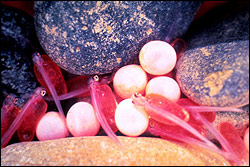We love our fish. Not only is the salmon a cultural icon in the Pacific Northwest, it has become a touchstone to nature for a lot of people. Perhaps it’s proximity. Spawning steelhead and salmon migrate right through the heart of metropolitan Seattle. After climbing the fish ladders of the Ballard Locks, they swim through lakes Union and Washington to return to the rivers and tributaries where they began life. In normal circumstances, about one egg in 1,000 survives to complete the cycle. In times of drought, the odds drop, especially when tributaries that fish use for spawning begin to dry up.
Despite recent rain, Washington’s fish will face an extra-dry summer because of reduced snowpack in the mountains. Normally, snowmelt releases water gradually into rivers during the dry season, giving them a boost when levels are especially critical for fish. Snowpacks are now completely gone at lower elevations.
In times of drought, the challenges to fish begin before they’re even born. Spawning fish lay eggs in nests they form in the streambed gravel. As tributaries dry up, fish that normally spawn there are forced to spawn in other areas of a river, sometimes jeopardizing earlier-laid eggs.
Juvenile fish depend on surges in steam flow to help them migrate downstream. In the fall, flows are critical as adult fish enter the rivers to spawn. Fish spawning downstream of Seattle’s water-supply and electricity-generating reservoirs are fortunate. There’s a minimum guaranteed stream flow that Seattle Public Utilities and Seattle City Light are required to spill to cover all or most nests, depending on the species.
Low water affects stream fish in a variety of other ways. As water recedes, there’s increased risk from pollutants. Stream temperatures rise, which causes stress in fish that can make them vulnerable to disease. Drought conditions also increase fire danger, and the consequences of fires are bad for fish. Fish stranded in isolated pools face additional perils; not only do they have to survive reduced oxygen levels, they’re easy targets for predators.
Low water levels also block fish migration. Small stream passages and tributaries that fish would normally access become impenetrable. Other blockages are avoidable. When the weather gets nice, some people can’t resist damming portions of rivers and streams to create private wading pools. Not only are these structures illegal, they stop fish migration.
Seattle Public Utilities, which supplies water to 1.3 million Seattle-area residents, and other agencies survey rivers daily, counting fish and identifying nests to maintain enough flow to keep them under water. Of special concern are the nests of chinook salmon, a threatened species, and the Cedar River sockeye salmon, which is the largest sockeye population in the state. With dams and reservoirs, the Cedar River is a major water supply for Seattle.
Seattle City Light, which has its own dams on several rivers, has found a way to create fish-friendly habitat by creating slow water areas in gravel along the Skagit River. “Just below a few feet, there is water flowing along with the river underground,” says Lynn Best, acting director for environment and safety at Seattle City Light. “By knowing where to dig, you create this little channel that has water flowing through it. You get adult fish spawning in there and juvenile fish coming in for protection. Those areas often stay viable even in a drought, because it is groundwater-fed, but that wouldn’t totally replace the tributaries.” Even with additional spawning areas, Best anticipates a lower survival rate for juvenile fish this year.
Washington has long struggled to balance the region’s needs for water and energy with stewardship of native fish. For one thing, fish have a significant place in the state economy. State Fish and Wildlife spokesperson Doug Williams estimates that commercial and recreational fishing industries generate more than $1 billion a year in business. This year, he says, chinook stocks in the Columbia River were a bit less than forecast. While some of the fish returning to fresh water are offspring of salmon that spawned in 2001, it’s hard to say whether declining numbers relate to a drought that year.
So what can we do to help the fish now? Everybody agrees the answer is use water wisely. When you think about those 1,000-to-1 odds against fish returning to spawn, it seems the least we can do is save a little extra water for them. Says Williams: “They can’t just get on a bus and go to the next river.”
Kirsten DeLara




